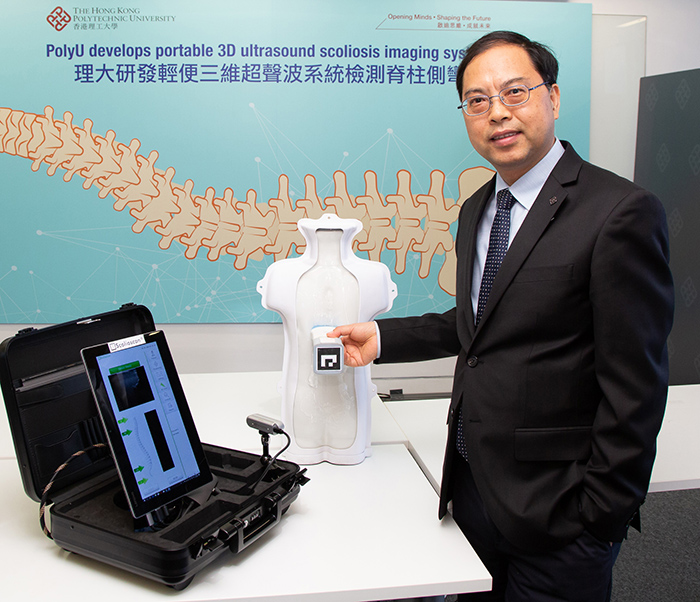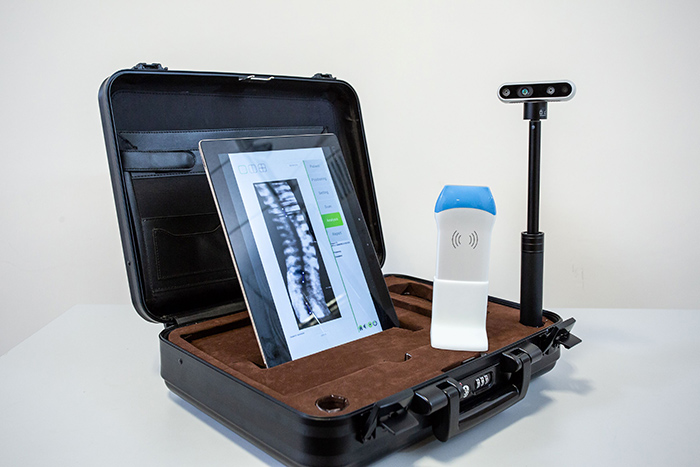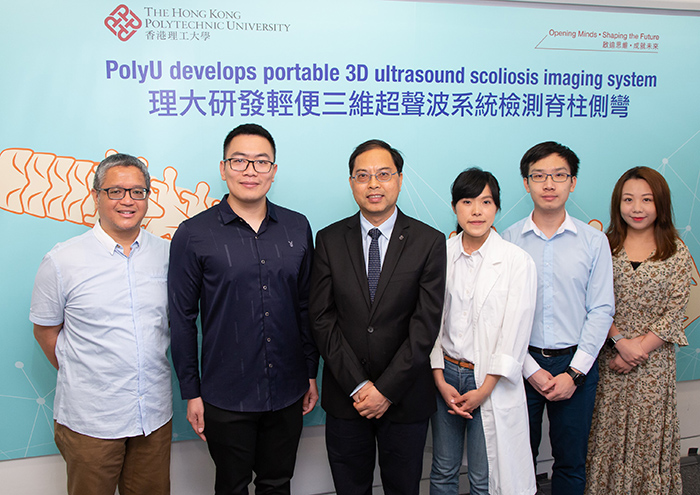In a press conference arranged by CPA which has been held on 2 May 2019, The Hong Kong Polytechnic University (PolyU) shared that more youngsters can have their scoliosis conditions detected early and monitored frequently, thanks to the portable imaging system developed by PolyU’s experts in scoliosis research. The first-of-its-kind palm-sized 3D ultrasound imaging system for radiation-free scoliosis assessment, named “Scolioscan Air”, can bring accurate, safe and cost-efficient mass screening to schools and anywhere in the community.
The portable Scolioscan Air developed by the research team of PolyU’s Department of Biomedical Engineering (BME) was recently awarded Grand Award, Gold Medal with the Congratulations of Jury, and Special Merit Award at the 47th International Exhibition of Inventions of Geneva held in April.
Scoliosis is one of the most prevalent spinal diseases affecting adolescents. It is estimated that about 3% to 5% of adolescents in Hong Kong suffering from scoliosis, with increasing prevalence in recent years.1 A recent study in Guangzhou indicated that for girls aged 14 and 15, the prevalence is as high as 13.8%. About 15% of the adolescents with scoliosis would have condition deteriorating, and bracing or surgery would be required when curves progress to moderate or severe status. Early detection of scoliosis conditions and regular check-up during the rapid growing period of adolescent school-children is thus crucial. At present, X-ray imaging is the clinical gold standard for scoliosis assessment, but radiation exposure may pose increased risk for cancer.
PolyU-developed scoliosis imaging technology
Ir Professor ZHENG Yong-ping, Head of BME and Henry G. Leong Professor in Biomedical Engineering, who leads the research, said Scolioscan Air is a further advanced system based on the PolyU-developed 3D ultrasound imaging technology under the trademark “Scolioscan” (weighed about 150 kg). “Scolioscan” was successfully commercialised into a clinic-based facility in 2016.
Being radiation-free and more cost-effective than prevailing X-ray imaging technologies,Scolioscan can facilitate mass screening and frequent follow-up monitoring. Clinical trials have proven the novel technology is very reliable, with accuracy of curve measurement comparable to X-ray assessment.2 3 Moreover, it can obtain image in any postures, provide vertebra rotation and muscle-related information, and form a 3D spinal model for the three-dimensional analysis of deformity of spine. All these cannot be achieved by X-ray imaging systems commonly used at present. Scolioscan can also be applied to conducting prognosis and monitoring treatment outcomes for each scoliosis patient so as to establish personalised treatment plan.
Palm-sized Scolioscan Air facilitates screening anywhere, anytime
The research team has recently applied the novel technology to a portable palm-sizedScolioscan Air they further developed, which weighed only 5 kg. “With this innovation, we can now literally bring the device and mass screening service to the youngsters anywhere, anytime. It would facilitate the implementation of school-based scoliosis screening to detect and treat spinal curvatures before they become severe enough to cause chronic pain or other health issues among adolescents,” said Professor Zheng. “Moreover, when providing non-surgical treatment for scoliosis patients, healthcare personnel can use Scolioscan Air to conduct real-time assessment, so as to optimise the treatment outcome.”
Scolioscan Air consists of three hardware components: i) a palm-sized wireless ultrasound probe with an optical marker mounted at its bottom; ii) a depth camera; and iii) a laptop or tablet computer with dedicated software. The compact optical marker and depth camera replace the spatial sensor used in Scolioscan and thus help dramatically downsize the device.
In addition, the technology for 3D ultrasound image reconstruction, visualisation and measurement, including a fully automatic curvature measurement method and 3D spinal deformity analysis software, developed by the team earlier can also be applied to Scolioscan Air.
The newly developed optical 3D spatial tracking method for Scolioscan Air achieves a high degree of accuracy, which is comparable with Scolioscan. Moreover, the technological compatibility makes Scolioscan Air readily available for commercialisation for popular use. With dramatically reduced material cost, size and weight compared with other scanning systems, Scolioscan Air can be carried within a suitcase.
Scolioscan has been registered as a medical device in different countries since 2016, including European Union and Australia. A total of 23 patents globally for the related technology have been awarded to, or filed by, PolyU and the collaborating company. The clinic-based systems have been installed in clinics in Hong Kong, Macau, the Mainland, Netherlands, Australia, Italy, etc; and have been used for scoliosis scanning for over 4,000 patients.
Members of the PolyU research team of Scolioscan Air include Mr MENG Qiang, Mr Derek YANG De, Mr Joseph HUI Chi-ho, and Mr Henry WONG Yiu-hang.



Note: Video on “Scolioscan Air”:- https://youtu.be/UQEWbaE3aOU
*****
[1]Fong , et al. A population-based cohort study of 94401 children followed for 10 years exhibits sustained effectiveness of scoliosis screening. Spine Journal. 2015;15:825–33
[2]Zheng et al. A reliability and validity study for Scolioscan: a radiation-free scoliosis assessment system using 3D ultrasound image. Scoliosis and Spinal Disorders (2016) 11:13
[3]Brink et al. A reliability and validity study for different coronal angles using ultrasound imaging in adolescent idiopathic scoliosis. The Spinal Journal 18(6), 2017.





